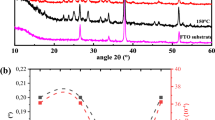Abstract
There is an enormous demand to develop novel TiO2-based photocatalytic material with higher photocatalytic activity due to its great performance in wastewater treatment. However, the exaggerated band gap of 3.2 eV for TiO2, which only absorbs the energy in the UV region, limits its application in wastewater treatment. In recent years, BiVO4 as a photocatalytic material has drawn considerable attention because of its appropriate ban gap of ~ 2.4 eV that allows a strong absorption in visible light region, excellent intrinsic charge transport properties, and suitable band location for recombination with other photocatalysts. In this paper, BiVO4@TiO2 nanorod arrays (NRAs) were fabricated on fluorine-doped tin oxide substrates via hydrothermal method, the structure and morphology of NRAs were observed by X-ray diffraction and scanning electron microscope, and the surface element and valence states were investigated by X-ray photoelectron spectroscopy. To confirm the improvement of photocatalytic performance after loading BiVO4 particles, methylene blue degradation test for before and after loading BiVO4 particle samples was carried out. The result indicates that the BiVO4@TiO2 NRAs sample shows a better degradation property than the single one, and the optimal parameter is 10 h with the concentration of 0.2 M. The capacity of photon carrier generation and electron–hole pairs migration was also investigated via UV–Vis diffuse reflection spectroscopy and photoluminescence spectra. The result illustrates that the absorption region is broadened by loading BiVO4 and the recombination of carriers is restrained efficiently, attributing to the transfer between TiO2 and BiVO4.









Similar content being viewed by others
Data availability
All data generated or used during the study appear in the submitted article. The datasets generated during and/or analyzed during the current study are available from the corresponding author on reasonable request.
References
A. Malathi, J. Madhavan, M. Ashokkumar, P. Arunachalam, Appl. Cata. A Gen. 555, 47–74 (2018). https://doi.org/10.1016/j.apcata.2018.02.010
Q.J. Shi, Z.J. Li, L. Chen, X.L. Zhang, W.H. Han, M.Z. Xie, J.L. Yang, L.Q. Jing, Appl. Catal. B Environ. 244, 641–649 (2019)
G.V. Khade, N.L. Gavade, M.B. Suwarnkar, M.J. Dhanavade, K.D. Sonawane, K.M. Garadkar, J. Mater. Sci.: Mater. Electron. 28(15), 11002–11011 (2017)
T. Wang, T.Y. Sun, J.H. Xu, H. Xiao, Z.G. Zhang, H.Q. Bian, H.H. Ding, J. Mater. Sci.: Mater. Electron. 32(16), 21083–21092 (2021)
Q.H. Li, M. Dong, R. Li, Y.Q. Cui, G.X. Xie, X.X. Wang, Y.Z. Long, Carbohydr. Polym. 253, 117200 (2021)
C.F. Carbuloni, J.E. Savoia, J.S.P. Santos, C.A.A. Pereira, R.G. Marques, V.A.S. Ribeiro, A.M. Ferrari, J. Environ. Manage. 262, 110347 (2020)
Z.Y. Duan, X.J. Zhao, L.M. Chen, J. Environ. Chem. Eng. 9(1), 104628 (2021)
R. Tong, X.N. Wang, X.L. Zhou, Q.Y. Liu, H.B. Wang, X.N. Peng, X. Liu, Z.H Zhang, H. Wang, P.D. Lund, J. Hydrogen Energy 42(8), 5496–5504 (2017). https://doi.org/10.1016/j.ijhydene.2016.08.168
H. Zhang, Y.M. Li, Y. Wu, Y.J. Wang, Z.P. Lin, D.D. Cao, Q.Y. Wang, Ceram. Int. 46(9), 13433–13441 (2020). https://doi.org/10.1016/j.ceramint.2020.02.126
M.D. Sun, Z,M. Zhang, Q.J. Shi, J.L. Yang, M.Z. Xie, W.H. Han, Chin. Chem. Lett. 32(8), 2419–2422 (2021)
M. Mehta, S. Krishnamurthy, S. Basu, T.P. Nixon, A.P. Singh, Mater. Today Chem. 17, 100283 (2020). https://doi.org/10.1016/j.mtchem.2020.100283
A.H. Shah, M.A. Rather, Mater. Today: Proc. 44, 482–488 (2021)
J.L. Jia, D.M. Liu, S.X. Wang, H.R. Li, J.X. Ni, X.B. Li, J.Y. Tian, Q. Wang, Sep. Purif. Technol. 253, 117510 (2020). https://doi.org/10.1016/j.seppur.2020.117510
Q.S. Shang, S.X. Gao, G.B. Dai, J.T. Ren, D.Y. Wang, Surf. Interfaces 18, 100426 (2020). https://doi.org/10.1016/j.surfin.2019.100426
J. Zhang, Q.T. Li, S.Q. Li, Y. Wang, C. Ye, J. Power Sources 268, 941–949 (2014). https://doi.org/10.1016/j.jpowsour.2014.06.139
Z.X. Jin, Y.L. Wang, S.X. Chen, G. Li, L.L. Wang, H.C. Zhu, X.T. Zhang, Y.C. Liu, RSC Adv. 6(13), 10450–10455 (2016)
J. Xie, W. Wen, Q. Jin, X.B. Xiang, J.M. Wu, New J. Chem. 43(28), 11050–11056 (2019)
S.P. Hong, J. Park, S.M. Bhat, S. Lee, T.H. Lee, S.A. Lee, K. Hong, M.J. Choi, M. Shokouhimehr, H. W. Jang, Cryst. Growth Des. 18(11), 6504–6512 (2018)
A.R. Nanakkal, L.K. Alexander, J. Mater. Sci. 52(13), 7997–8006 (2017)
R. Wang, J. Bai, Y.P. Li, Q.Y. Zeng, J.H. Li, B.X. Zhou, Nanomicro Lett. 9(2), 14 (2017)
Z.X. Wang, S.B. Huang, Z.C. Jian, J.Z. Yin, Z.B. Fei, Y.Q. Zhang, Res. Chem. Intermed. 42(5), 4147–4159 (2016)
J.J. Sun, X.Y. Li, Q.D. Zhao, M.O. Tadé, S.M. Liu, J. Mater. Chem. A 3(43), 21655–21663 (2015)
Acknowledgments
This work was financially supported by the National Natural Science Foundation of China (Grant No.11874124), the Science and Technology Project of Guangdong Province (Grant No. 2017B010127002), and the Joint Training Demonstration Base Project of Guangdong Province Graduate student in 2016.
Author information
Authors and Affiliations
Contributions
All authors contributed to the study conception and design. The conception of the study was contributed by WZ and WX. Material preparation, data collection, and analysis were performed by JL, CR, and SZ. The data collection and analysis were performed (XRD, XPS) by XS and ZH. The first draft of the manuscript was written by JL. The analysis with constructive discussions and manuscript writing guide were performed (XRD, XPS) by ZF and YC. All authors commented on previous versions of the manuscript. All authors read and approved the final manuscript.
Corresponding author
Ethics declarations
Conflict of interest
There is no conflict of interest to declare.
Additional information
Publisher’s Note
Springer Nature remains neutral with regard to jurisdictional claims in published maps and institutional affiliations.
Rights and permissions
About this article
Cite this article
Liang, J., Zhang, W., Xie, W. et al. Photocatalytic activity of BiVO4@TiO2 composite nanorods arrays. J Mater Sci: Mater Electron 33, 12426–12435 (2022). https://doi.org/10.1007/s10854-022-08200-1
Received:
Accepted:
Published:
Issue Date:
DOI: https://doi.org/10.1007/s10854-022-08200-1




